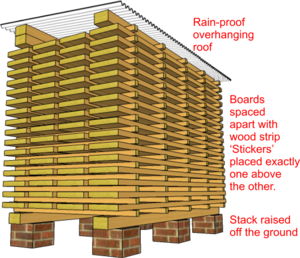Seasoning
From DT Online
Introduction
Over half the weight of a growing tree is water or Sap. Freshy Felled or Green timber with such a high Moisture Content (MC) is susceptible to attack by Fungi and may crack, warp and twist if dried out too quickly.
Timber with greater than 20% MC is prone to decay and shrinkage starts as the timber dries below approximately 30% MC.
Seasoning is a controlled drying process to reduce the Moisture Content (MC) of the Converted timber until it approximates the surroundings or environment where it will be used. This Equilibrium Moisture Content (EMC) and ranges from10% to a 20% approximately, dependent on whether for interior or exterior use.
Moisture Content
The most commom method of checking Moisture Content is to take advantage of how moisture affects Electrical Resistance. An electrical resistance meter, or Moisture Meter, (specified in BS EN 13183-2: Moisture content of a piece of sawn timber. Estimation by electrical resistance method), has two probes which are pushed into the wood, about 300mm from the end, and a resistance reading taken which is automatically converted into Moisture Content. Other types of meter are available which avoid damage to the wood surface.
History
Vitruvius, a military engineer who served the Roman army under Julius Caesar, specialised in the construction of Siege Weapons for which he needed to source large timbers. He was concerned about what we would now call Moisture Content and Seasoning before use to reduce the risk of cracking and distortion. In his book De Architectura he states: In felling a tree we should cut into the trunk of it to the very heart, and then leave it standing so that the sap may drain out drop by drop throughout the whole of it. . . . . Then and not till then, the tree being drained dry and the sap no longer dripping, let it be felled and it will be in the highest state of usefulness. In other words, the tree is killed, but left standing until dry enough for use.
There is evidence (e.g. in De Re Aedificatoria written by Leon Battista Alberti in the mid-15th Century) that this method was practiced also in Medieval Europe but this is not to say that all timber was Seasoned before use. The large timbers needed for house construction would have taken years to Season naturally and Green timber is easier to work. A high proportion of the timbers in medieval buildings were riven or Cleaved - (ref: ‘Traditional Timber Framing - A Brief Introduction’ from University of the West of England).

